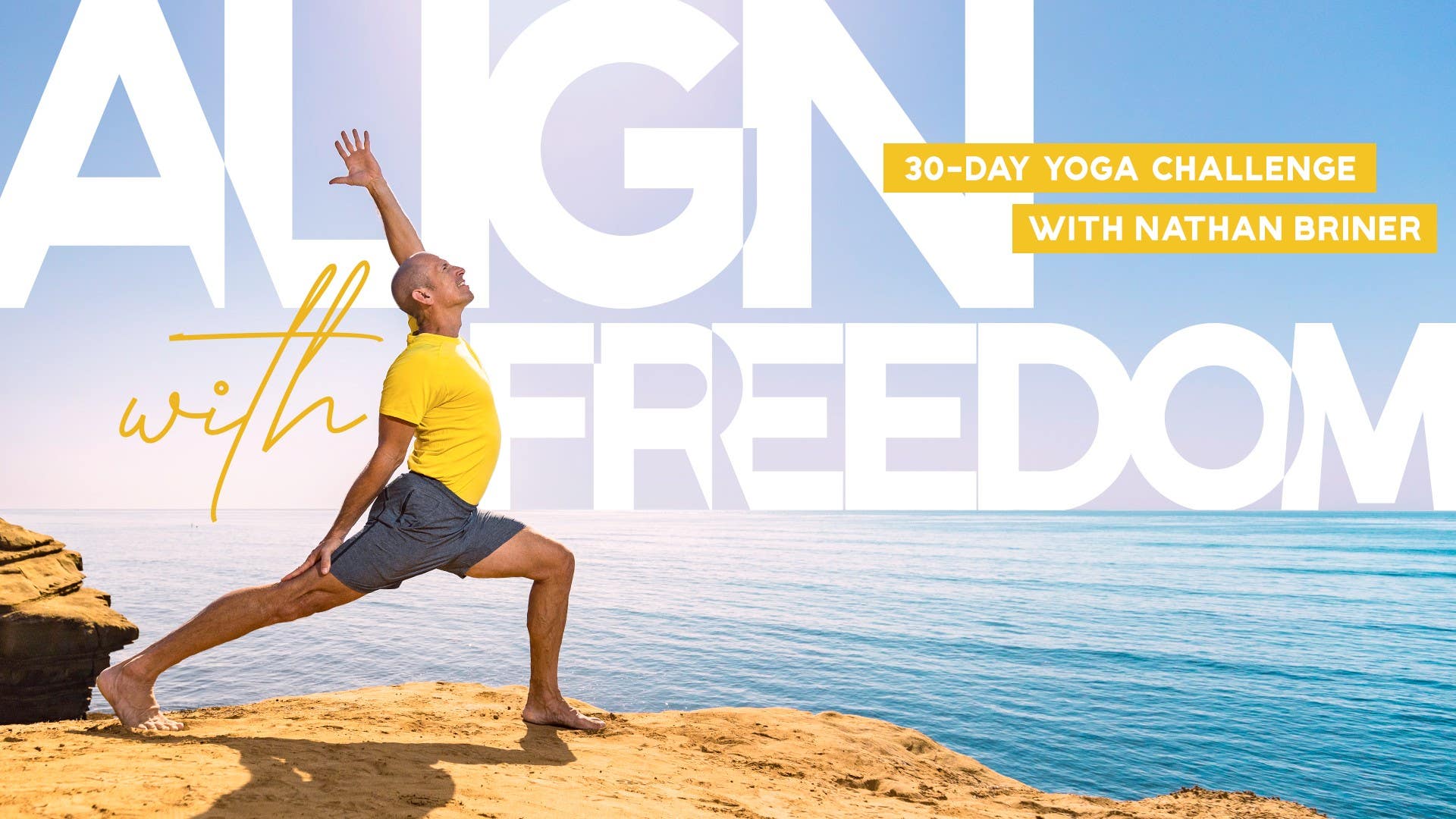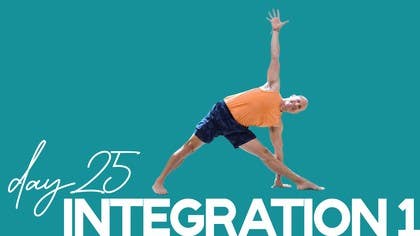Description
About This Video
Transcript
Read Full Transcript
Welcome back to day 23 of our 30-day challenge. And let me just start by saying great job for coming again to the mat today and joining me in this practice. How are you feeling after the Hanuman sequence? Any stiffness? Any new experiences you've got going on? Before we jump all the way into our practice today I thought I'd just quickly mention a brief difference between mobility and flexibility. And that being what I'm trying to help encourage in mobility is access to all of our range of motion. Whereas flexibility I see sometimes people will misconstrue as just being bendy and going and going and going into poses. So yes that flexibility we're looking to encourage but it's just our natural range of motion and exploring and existing and all that. Not only physically but even mentally. All right let's start out today in cross legs a little similar to how we started out our last session and we'll start working on that mobility flexibility here. Let's come forward into a forward bend and we'll start our inner exploration seeing how the body feels folding. We're going to be working a little bit deeply into the hips again today so I'll ask you to start to bring your attention there. And then walking back up let's get the other side. Cross legs forward fold hips heavy down onto the mat folding from the hip joints.
So this is a chance for you to check in in terms of flexibility and mobility. Do you feel a boundary at your hips that you're maybe trying to push through? That could just be the end of your hip range of motion. Something to really study inside so that you don't take it too far. Just learning to work within your given range of motion. And then coming back up we're going to grab a block for the next pose. Something we've worked on a little bit before. This is bada konasana, bound to angle pose and we'll start with the block at that setting in between the feet. Hold on to the feet for just a moment and lift your spine up. If you need a blanket maybe for a little extra height in the spine that might be a nice thing to grab right now before we go a little deeper. And then with the sacrum well lifted coming forward again from the hip joints. And in this pose I'll ask you not to drive your knees hard into the floor but let them just be there hovering in space. We'll ease into our work today. We're not going to have a lot of heating poses, standing poses in this particular routine so we're letting time and gravity and patience do the work.
And as we hold the pose, it gives us a better opportunity to feel what's going on. Is there a holding pattern in one of the hip joints different from the other? Almost an unwillingness to come forward that we weren't aware of that we could let go into. Let's come up, change the block for a little bit more depth. If that's available to you, the widest setting there, again capture the feet, we'll start by lifting up the sacrum and then coming forward. Sacrum is the back of the pelvis. I think it's important to tap into not only physical flexibility but remember the point of our yoga is to go beyond that physical into the inner world, the mental. And we can tap into our ability to flow with our world, to change, to adapt, that water element that we're tapping into.
All right and then come up, we'll put the block off to the side and as a counter pose we'll come into Vadrasana. Legs are together, a little tiny squeeze of the legs as a counter pose, sitting up nice and tall. Just hold here, close the eyes and feel. And then eyes open, we'll take a seat now, legs stretched out in front. This might be a really nice time to grab a folded blanket for under the hips. And then we're going to come back folded blanket for under the hips. Nice thick folded edge pointing toward the toes. You can reach underneath one sits bone at a time, pull the skin and muscle back. This next pose is called Akarna Dhanurasana or archers pose. We're going to start with a bend of the left knee and we're working on the mobility of the left hip. Curl up the toes, reach to grab the outside of the left foot. Other hand can be on your right leg. I'm going to draw that leg up, the left leg up and slowly start to pump the left leg and knee behind us. So my intention is to try to get the left knee to go past my body line. Every body is different so you have to see what's working for you. The shin we're going to keep more or less parallel to the floor. And as I'm doing this, I'm allowing my pelvis to turn slightly open toward the left side. A few more times. Sometimes I like to think of this as like this is a telephone and we're trying to hello that kind of thing and then release.
Let's do the second side. We'll bend the right foot, a knee foot just off the ground. We'll reach for the pinky side of the right foot, left hand supporting on the left thigh. Start easy, lifting up your spine. We can rely on all that strength we've been working on in our core sequences previously here. And from that stability of the trunk, we'll start to draw the right knee back. I keep the right shin more or less parallel to the floor and working that pumping action, trying to take the right knee behind the body line. You really have to feel into the right hip to see that you're allowing that motion to come. A couple more. And then release. We'll set the blanket off to the side for a higher lift and let's bring the belt nearby as well. Sitting up on the block, this is Marichyasana one. We'll start by drawing the left leg bent and the foot in close to the sits bone. Nice and tall spine. We'll be starting with the twist of Marichyasana. Let's take the left elbow to the inside of the left leg and use the pressure of the arm against the knee to begin to turn the trunk. If you like, you can take the back of your right hand against the trunk as an additional help to turn. Again, this pumping action. And we can take it a little bit further into a bind with the arms. To do that, I'm going to pick up the strap with my right hand. Again, right arm behind the body and holding the strap just to the side of the left leg. Left arm, I'm going to reach around that leg and we have contact. I push the left arm against the left knee. I push the left knee against the left arm and this creates a twist in the body. Right shoulder rolling back and then release. We'll set the strap down for a moment. Straighten the left leg, draw the right leg back and the right heel in close to the sits bone. We'll start with the right elbow just inside the knee and I'm pushing the elbow against the knee and the knee against the elbow and that creates my twist to help open the hip. Then I'll hold that, take the left arm behind the back, holding there. I keep the left leg strong, top of the thigh pointing straight up.
And then I'll release and we'll try for the bind. Holding the strap with the left hand, I'll bring that around the back. I reach a little forward to help deepen the hip, action of the right leg and going for the bind. You know, there's so many different alignment cues in yoga and the point of all of those is to help us find the mobility in the body safely. But once the mobility is found to use that alignment of the pose to create a situation where the mind actually goes quiet, that is where the beauty really starts to emerge in a deep yoga practice. Of course, there's beauty all along the way, but that's what we're really aiming at. And then release, let it go. Extend the right leg. We'll take Marichasana one a little bit deeper now. Left leg in, heel close to the sits bone. We'll start with our setup as before. I'm going to reach forward with the left arm once. Inhale, exhale twice and we'll do it once more. So I'm reaching way out, wrap around the shin. Now if you don't need the strap and you can catch hands, catch hands. If you still need the strap, grab it now. We'll take a breath in, turn the trunk so the chest is square to the floor and folding toward the right leg. Marichasana. Take a few breaths here and we squeeze the body with the arms to move us a little deeper into the pose.
And then easy up and release. Left leg long, right leg back. We'll do a few reaches to help get a little depth into the pose. One, inhale, exhale, reaching the right arm. Two, last one, reach, hold that length, sweep the right arm around the right shin. Working for the bind, we'll turn a little into the twist we practiced before. Then holding that bind, squeezing the body with the arms, I'm going to turn the chest parallel to the floor and now I come forward. So having mentioned what I did about the alignment and the ability to bring a quietness of the mind, it becomes our guidepost to see how well we're doing in the pose. Is our mind stirred up or quietened? Takes us beyond just the physical part of the pose.
And then release, straighten both legs just for a moment. We'll tighten the knees, take the fingertips to the floor, and then release. Come down off the block. We'll put the block off to the side, strap out of the way. Let's get that blanket again. Wide leg forward fold. Extend the legs out to the sides. As we did before, we can reach underneath the hips, pull the skin and muscle back, and that gives us an ability to lift way up in the spine. Let's take the fingertips to the blanket. Firm legs push down, hands press down, and create some lift in the trunk. So I engage the feet, the leg muscles, pressing the floor with the arms. And then our first version of the pose will be coming forward in a forward fold, press the legs firmly down, and we'll come out about this far first and re-engage the contact, legs into floor. So you can practice even here experiencing what I'm talking about with the alignment and the efforts of the pose. If you let go of all muscle energy, there becomes kind of a sinking sort of dullness to your awareness. Activate the legs, your awareness becomes brighter, more spacious. We'll come out a little bit further, if that's available to you. If you're not used to feeling awareness in that way, it may take a little while for that connection to experience that. You can continue coming out to your mobility level, and we'll walk back up. We'll be taking it off to the side now down the left leg. I'll start with a turn of the trunk, pointing my chest down the left side. And then folding forward, I can take the right hand toward the left foot. It could be right hand here, even here, if that's your mobility. And then I pull with the right hand and take the trunk down to a level that's comfortable for me. What level is comfortable for you? And just because you see someone maybe go deeper or not quite as deep, doesn't mean a thing. You do what your body can do.
And coming up, pause in the middle, get that lift in the body. Let's go to second side. Twist first, and then we'll take it down toward the right leg. Roll the left side trunk down. That's an action we've explored before. Roll the left side trunk down toward the yoga mat, and coming into your depth. And then coming back up nice and easy, lean back, grab the inside edges of the legs.
Take one, take two, and just a moment and cross legs. Let the body recover. Take a scan inside. And then we'll come down off the blanket. Let's take a downward dog. If you like to pedal out your feet a little bit, it's a nice opportunity to do that. High heels, sharpen the crease of the legs where thigh and pelvis meet. And then keeping that fold in the thighs and chest moving toward the knees, slowly stretch the heels down to the floor or near the floor or not near the floor, whatever your body can do.
High heels again, right foot way forward into a lunge. We're going to turn toward the length of the mat into wide leg standing forward fold. We'll start here engaging the legs into the floor, so we've got a nice strong foundation. Balancing right side, left side, the power of connecting to the muscles and now the flexibility, the mobility. Walk the hands in between the feet, shoulder width apart. Bend the elbows, take the head toward the floor any amount while keeping the thighs very, very firm, lifting space between the two hip joints, hands, shoulder bones lifting up away from the ears and lifting back up. We're going to shift now over to the left side, walk the hands over. We'll take the right hand as far as reasonable for our body and like the seated forward fold, bring the trunk down toward the left leg. Coming back to center, pause in the middle, working to the right side. Coming back to center, we're turning to downward facing dog again, hands to the front end of the mat. Step back to your dog pose and bring the feet together and we'll come into an easy pigeon pose. Left foot forward, point the right toes back, you can slide that right leg back and this time in pigeon pose we'll be bringing the forearms down to the floor or at least attempting that. We'll have the right forearm on the floor, the left hand to the left knee and an easy twist to the side. Take a few breaths here, just working a little bit further into that hip mobility on the left side and then undo, toes tuck under, brief stop in dog pose, second side, right leg forward, left leg down. Coming down to forearms and left forearm on the mat, right hand to right knee, we take an easy turn to the right side with the trunk and then release. Coming up to dog pose for a moment and then lower the knees down to the ground. Our next stop, the peak pose that we're after today is going to be the half bound lotus. I think having a blanket will be really nice to give it some elevation for the hips and a strap to help us in the pose. Come up onto the blanket and extend the legs out. You can reach underneath the hips, slide the skin and muscle back.
We'll start with the left leg for half lotus. We'll bring the leg out to the side, bring the shin up and take the foot across the thigh. And depending on your mobility and your actual structure in your hip, this might be as far as you go today. But we'll try it a little further and see how you do. We can come underneath the leg, lift and draw the heel a little closer to the right hip, still lifting through the spine. And you can work on this just little by little, bringing the heel in closer and closer to your tummy. Some folks will be able to drop that left knee right to the floor. My body won't do that, so I'm not going to push that. You might even appreciate a block underneath your left knee. To take the pose a little bit further, we can do a bind if that's available to you and if the foot is up close to your tummy. We're going to take the strap around the left foot so that we can reach from behind to capture it. And this helps to lock in that leg a little bit better. Right? And just holding, feeling into your pose. And then we'll release. Let the strap go, lean back, take the leg out, and we'll do the second side. Lift up tall, right leg out to the side. And I can say that my right leg is definitely the stiffer of the two because an earlier accident I had when I was a kid, so I always have to be a little bit more careful on that side so I don't take out the flexibility into the knee. We'll start with the foot across the thigh and just get a sense how your body is doing with it.
If we can take it a little bit further, we can draw the heel in closer to the left side tummy, still working on sitting up tall. How's your right knee? How is the hip? Feel into your body. Got a feel first, then we can move. We'll take the strap around the right foot as long as the foot is in close to your tummy. You can see how that bind looks here. I'm just holding. I try to draw that right foot deeper in. And then release. Nice. We'll take the foot down, put the strap off to the side, blanket off to the side. Now we get to have a little bit of fun with all the flexibility that we've been working on. Upavistha Konasana. We'll start here. Feet in front, toes up. Let's grab the outsides of the feet. Lean back. Balancing. There we go. And we'll just start here. Bent legs. Lift your spine. Lift the sacrum back of the pelvis. And then bring it down. You could either stay there, or if you're ready for a challenge, two fingers and thumb. First part, bent knee pose. And then we'll challenge all the way up. Can we balance? Lift the sternum. Strong straight arms. And rest. Great job. Let's do a little counter posing. We will turn on to the back. Lie down. Cross your legs. Just like classic crossleg sitting. And allow the knees down into the floor. This position helps create a little arc in the lower back. It's a nice counter pose to the forward bending we've been doing in this in the previous routines together. You can let your arms down on the floor.
Let's cross the legs the other way. And again, allow the knees to rest toward the floor to help draw a little of that lumbar arc into play. Might be a nice pose to take if you've been sitting at a desk for a while and you need a little refresher for your back. If you can lie down, cross the legs and help draw that natural lumbar curve back into place. We'll do one more counter pose here. We'll start with the legs out straight. Bring your hands right next to you and grab a hold of your shorts or your yoga pants or whatever you've got on there. Hold on tight. Push your elbows into the mat and lift your chest a little. Open your chest. Tip the head back to touch the mat. So you can hold on and try to bring the back of the head just a wee bit closer to your tail. Engage your spinal muscles. Legs strong, strong, strong. And then press the elbows, little lift of the head and drop the head down. You can bend your knees for a moment. We're heading into Shavasana. So you can lengthen out the hips. And if you'd like, I'd highly recommend it. A little blanket for behind your head. And again, adjust the hips. The low back is long. Still has its arch under it. Extend your legs out one by one. Gentle tuck of the shoulders. And then slowly relax all the muscle energy so you can begin to let go. Deep hip work can be really calming to the nervous system because we can hold a lot of tension in the hips either by way of the activities that we do or regular sitting times. Taking some time to address those hips through a few yoga poses can be really helpful to bring a calm, quietening mind. Let's let go from that center line out to the sides and rest in distillness. So please do stay as long as you need in your Shavasana. If you're ready to come out, rest your hands on your tummy. Bend your legs one at a time and turn softly off to your right side. Let's rest there for a breath or two. And use your hands to press up into a comfortable position for yourself.
We've done some deep work together in this theme of flexibility. Our next sequence is going to be focused a little bit more on back bending, as opposed to more the hip work we've been doing. As always, I would love to hear from you. I hope you have a tremendous day. Take care. Namaste.
Align with Freedom: 30-Day Yoga Challenge
Comments
You need to be a subscriber to post a comment.
Please Log In or Create an Account to start your free trial.





















